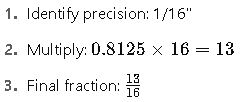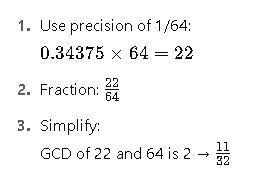In mechanical, construction, and manufacturing fields, precise inch measurements require converting decimals to fractions accurately.
This calculator simplifies conversions, aiding engineers and technicians with formulas, tables, and exact fractional outputs.
Inches to Fractions Calculator
Common Inch to Fraction Conversion Table (1/64″ Increments)
Below is a reference table that converts decimal inch values to their closest common fractional inch equivalents in increments of 1/64”. This resolution is typical in precision machining and high-quality craftsmanship.
| Decimal (in) | Fraction | Simplified | Millimeters (mm) |
|---|---|---|---|
| 0.0156 | 1/64 | 1/64 | 0.3969 |
| 0.0312 | 2/64 | 1/32 | 0.7938 |
| 0.0469 | 3/64 | 3/64 | 1.1906 |
| 0.0625 | 4/64 | 1/16 | 1.5875 |
| 0.0781 | 5/64 | 5/64 | 1.9844 |
| 0.0938 | 6/64 | 3/32 | 2.3813 |
| 0.1094 | 7/64 | 7/64 | 2.7781 |
| 0.1250 | 8/64 | 1/8 | 3.1750 |
| 0.1406 | 9/64 | 9/64 | 3.5719 |
| 0.1562 | 10/64 | 5/32 | 3.9688 |
| 0.1719 | 11/64 | 11/64 | 4.3656 |
| 0.1875 | 12/64 | 3/16 | 4.7625 |
| 0.2031 | 13/64 | 13/64 | 5.1594 |
| 0.2188 | 14/64 | 7/32 | 5.5563 |
| 0.2344 | 15/64 | 15/64 | 5.9531 |
| 0.2500 | 16/64 | 1/4 | 6.3500 |
| … | … | … | … |
Tip: For full-resolution charts up to 1″, download ASME Y14.5 standard or visit NIST.gov.
Key Formulas for Decimal to Fraction Conversion
An Inches to Fractions Calculator follows a set of mathematical operations to convert a decimal number into its fractional approximation based on a specified denominator (commonly 64, 32, or 16).
1. Fraction Conversion Formula
To convert a decimal to a fraction rounded to the nearest denominator:
Where:
- D= Decimal inches (e.g., 0.1875)
- N= Precision denominator (e.g., 64, 32, 16)
- Round= Nearest whole number
Example:
Convert 0.1875 inches to the nearest 1/16:
2. Fraction Simplification Formula
Once a fraction is calculated, simplify by dividing both numerator and denominator by their GCD:
Where:
- a= numerator
- b= denominator
3. Millimeter Conversion Formula
To support metric environments:
Choosing the Right Precision: 1/8″, 1/16″, 1/32″, or 1/64″?
Depending on the application, the right fractional resolution varies:
| Application | Typical Fractional Resolution |
|---|---|
| Rough Carpentry | 1/8″ |
| Finish Carpentry | 1/16″ |
| Cabinetry & Woodworking | 1/32″ |
| Machining & Tolerances | 1/64″ |
Pro Tip: Higher denominators give more precision but may introduce complexity in manual tools or visual readings.
Real-World Example 1: Woodworking Application
Problem:
A cabinet installer needs to cut a piece of wood measuring 0.8125 inches in thickness to match the profile of existing shelves. The table saw is marked in 1/16” increments.
Solution Steps:

Answer: The cut required is 13/16 inches
Explanation: Fraction calculators simplify on-site measurements and reduce manual math, preventing costly errors.
Real-World Example 2: Engineering Design on CAD
Problem:
A mechanical part designed in AutoCAD has a slot width of 0.34375 inches. The drawing must be annotated using fractional inches for fabrication in an imperial-based workshop.
Solution Steps:

Answer: The slot width is 11/32 inches
Benefit: Accurate CAD annotations using standard fractions ensure interoperability between engineering and fabrication teams.
Extended Inch to Fraction Table (up to 2” in 1/64″ steps)
Here’s a continued conversion chart for common decimal to fractional inch values used in engineering and trades.
| Decimal (in) | Fraction | Simplified | mm Equivalent |
|---|---|---|---|
| 0.3125 | 20/64 | 5/16 | 7.9375 |
| 0.3750 | 24/64 | 3/8 | 9.5250 |
| 0.4375 | 28/64 | 7/16 | 11.1125 |
| 0.5000 | 32/64 | 1/2 | 12.7000 |
| 0.5625 | 36/64 | 9/16 | 14.2875 |
| 0.6250 | 40/64 | 5/8 | 15.8750 |
| 0.6875 | 44/64 | 11/16 | 17.4625 |
| 0.7500 | 48/64 | 3/4 | 19.0500 |
| 0.8125 | 52/64 | 13/16 | 20.6375 |
| 0.8750 | 56/64 | 7/8 | 22.2250 |
| 0.9375 | 60/64 | 15/16 | 23.8125 |
| 1.0000 | 64/64 | 1 | 25.4000 |
| 1.1250 | 72/64 | 1 1/8 | 28.5750 |
| 1.2500 | 80/64 | 1 1/4 | 31.7500 |
| 1.5000 | 96/64 | 1 1/2 | 38.1000 |
| 2.0000 | 128/64 | 2 | 50.8000 |
Online Inches to Fractions Calculator: Implementation Insights
An online Inches to Fractions Calculator is a dynamic tool designed to automate the conversion process and support both professionals and students. To ensure precision and user-friendliness, key implementation components include:
Key Functional Features
- Decimal Input Field
- Accepts user-entered values (e.g.,
0.875) - Supports up to four decimal places for accuracy
- Accepts user-entered values (e.g.,
- Precision Selector
- Dropdown to choose precision (1/8″, 1/16″, 1/32″, 1/64″)
- Live Output Field
- Displays equivalent fractional inch (both unsimplified and simplified)
- Optional Metric Output
- Converts decimal inch to millimeters automatically
- Error Handling
- Includes validation for negative, non-numeric, or out-of-range inputs
Step-by-Step Manual Conversion Method
If you don’t have access to a calculator, here’s how to manually convert inches to fractions:
Step 1: Choose Precision
Select your target denominator based on required precision (e.g., 64 for high accuracy).
Step 2: Multiply
Multiply the decimal inch by the chosen denominator.
Step 3: Round
Round the result to the nearest whole number.
Step 4: Simplify
Find the greatest common divisor (GCD) and reduce the fraction.
Example:
Input: 0.8125 inches
Denominator: 64
Calculation:
0.8125 × 64 = 52
→ Fraction: 52/64
→ Simplified: 13/16
Authoritative Resources & Industry Standards
For professionals seeking deeper insights, calibration data, or industry-compliant specs, here are trusted references:
- NIST (National Institute of Standards and Technology)
- U.S. agency for measurement standards and fractional tolerance
- ASME Y14.5-2018
- Geometric Dimensioning and Tolerancing guidelines
- ISO 2768-1:1989
- General tolerances and fractional rounding in manufacturing
- Engineering Toolbox
- Online tables and engineering tools
Frequently Asked Questions (FAQs)
1.What is the most common fraction in woodworking?
Answer: 1/16″ and 1/8″ are most common due to ease of measurement and sufficient precision.
2.How accurate is rounding to 1/64″?
Answer: It provides precision up to ~0.0156″, suitable for metalworking and tight-tolerance designs.
3.Can I convert millimeters directly to fractional inches?
Answer: Yes. Convert mm to inches using:
Then apply the decimal-to-fraction method.
4.Why do we simplify fractions?
Answer: Simplified fractions are easier to read, interpret, and use on tools and drawings (e.g., 4/8 → 1/2).
5.Is there a difference between 0.5 and 1/2 inch?
Answer: No. They are equal, but decimal is better for computation, and fraction is better for fabrication.
Pro Tips for Professionals
- Use digital calipers that show both decimal and fraction outputs for increased versatility.
- In engineering drawings, always include a tolerance value (e.g., 1/2″ ± 0.01″) when using fractional dimensions.
- For CNC and CAD, prefer decimals internally, and convert to fractions only when exporting specs for manual fabrication.
Summary: When and Why to Use an Inches to Fractions Calculator
| Use Case | Benefit |
|---|---|
| Woodworking and carpentry | Faster cut setup, avoid tape errors |
| Engineering design | Ensures drawing-manufacturing alignment |
| Student learning | Improves conceptual understanding |
| Metric-to-imperial work | Simplifies conversions and fabrications |
An Inches to Fractions Calculator bridges the gap between design, mathematics, and real-world execution, ensuring that measurements are not just correct, but understood, standardized, and applied effectively.





